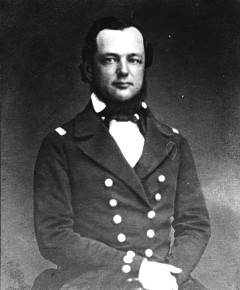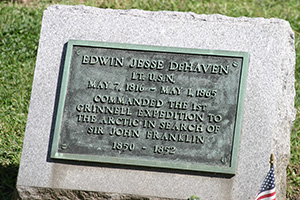Lieutenant Edwin Jesse DeHaven
 Lieutenant Edwin Jesse DeHaven became a well known explorer through his wide
travels and expeditions. Lieutenant Edwin Jesse DeHaven became a well known explorer through his wide
travels and expeditions.
Of Dutch descent, Edwin Jesse DeHaven was born on May 7, 1816 to parents William and Maria (McKeever) DeHaven in Philadelphia, Pennsylvania.
Appointed Midshipman on October 3,1829, he was
commissioned Lieutenant on September 8, 1841. His early service was recorded in
the West Indies and in South America onboard the ships NATCHES, ERIE, and
the LEXINGTON where he achieved the rank of passed midshipman.
After a tour of shore duty in New York and Baltimore, DeHaven was transferred to the FALMOUTH in the Pacific and in 1839 to the
USS VINCENNES, flagship of the U.S. Exploration Expedition under Charles
Wilkes. On this vessel, Lieutenant DeHaven made his cruise to the Atlantic and
among the Pacific Islands. He was transferred to the USS PEACOCK in
October 1840, which continued with the expedition in surveying portions of
the Pacific and the North American Court near Puget Sound. On July 18,1841, the PEACOCK was wrecked in the mouth of the Columbia River where DeHaven was reputed to have saved the lives of several crew members. After being promoted to Lieutenant, DeHaven finished the expedition on the
USS OREGON.
During 1843 he served aboard USS TRUXTON and in January 1845 was
transferred to the USS SOMERS where he served as the recruiting officer. The SOMERS was active in the Gulf of Mexico
during the early part of the trouble with Mexico, and participated in the
first expedition against Alvarado. In 1848, he was assigned to the steamer USS MISSISSIPPI, seeing action in the Mexican War, including duties charting the Gulf of Mexico.
After a brief tenure at the Naval Observatory in Washington , DC, on May 3, 1850, Lieutenant DeHaven was placed in command of the Grinnell
Rescue Expedition to search for Sir John Franklin who had disappeared during an expedition in the Arctic in 1845. Two ships of the expedition, the brigs ADVANCE and RESCUE, were caught in the ice west of Greenland in September and drifted
for nine months. The Expedition found only traces of Franklin, but discovered
and named Grinnell Land, now part of Ellesmere Island, Canada. The expedition returned to New York on September 30, 1851.
 In 1852, DeHaven sailed aboard the sloop-of-war USS DECATUR in the North Atlantic, guarding American fishing interests. Shortly thereafter, in 1853, DeHaven transferred to the Coast Survey, commanding a survey team consisting of the schooners ARAGO and BELLE. After four years of service with the Coast Survey, which included, among other duties, conducting deep-sea soundings off the southern coast of the U.S. DeHaven was detached from the Coast Survey on February 19, 1857 due to deteriorating eye sight, and was officially placed on the retired list in 1862. Edwin Jesse DeHaven died in Philadelphia on May 1, 1865 and was buried in Old Christ Church Burial Ground, Philadelphia. He was survived by his wife, Mary Norris DeHaven, and at least two children, a son Norris and a daughter Kate. In 1852, DeHaven sailed aboard the sloop-of-war USS DECATUR in the North Atlantic, guarding American fishing interests. Shortly thereafter, in 1853, DeHaven transferred to the Coast Survey, commanding a survey team consisting of the schooners ARAGO and BELLE. After four years of service with the Coast Survey, which included, among other duties, conducting deep-sea soundings off the southern coast of the U.S. DeHaven was detached from the Coast Survey on February 19, 1857 due to deteriorating eye sight, and was officially placed on the retired list in 1862. Edwin Jesse DeHaven died in Philadelphia on May 1, 1865 and was buried in Old Christ Church Burial Ground, Philadelphia. He was survived by his wife, Mary Norris DeHaven, and at least two children, a son Norris and a daughter Kate.
Read more about the Exploration Expedition in the following book:
|